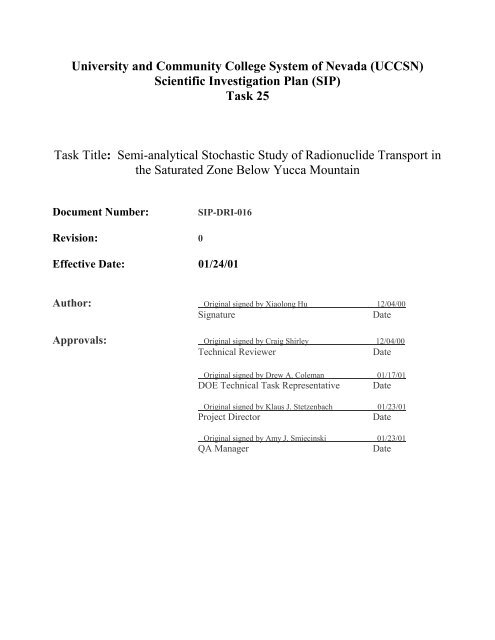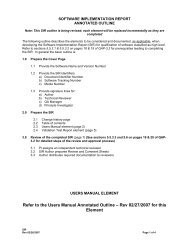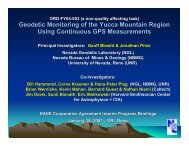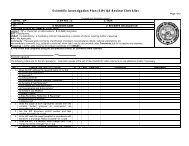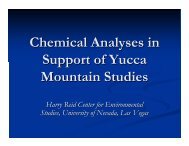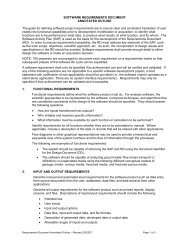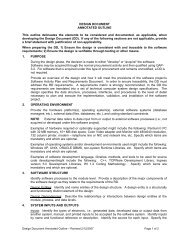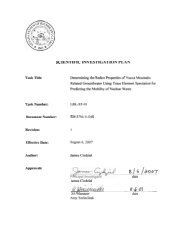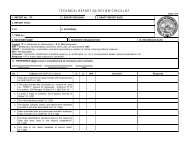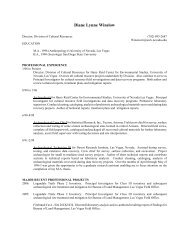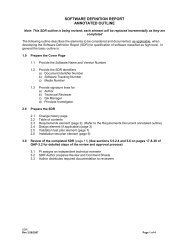Semi-analytical Stochastic Study of Radionuclide Transport in the ...
Semi-analytical Stochastic Study of Radionuclide Transport in the ...
Semi-analytical Stochastic Study of Radionuclide Transport in the ...
You also want an ePaper? Increase the reach of your titles
YUMPU automatically turns print PDFs into web optimized ePapers that Google loves.
Title: <strong>Semi</strong>-<strong>analytical</strong> <strong>Stochastic</strong> <strong>Study</strong> <strong>of</strong> <strong>Radionuclide</strong> <strong>Transport</strong> <strong>in</strong> <strong>the</strong> Saturated ZoneBelow Yucca Mounta<strong>in</strong>Document No.: SIP-DRI-016/Rev. 0 Page 1 <strong>of</strong> 71.0 APPROACHThe complex heterogeneity <strong>of</strong> <strong>the</strong> natural media and <strong>the</strong> uncerta<strong>in</strong>ty <strong>in</strong> data for <strong>the</strong> saturated zonebelow <strong>the</strong> Yucca Mounta<strong>in</strong> project (YMP) area preclude us<strong>in</strong>g traditional determ<strong>in</strong>istic approachesto model solute transport. To overcome <strong>the</strong> scale dependence <strong>of</strong> hydraulic parameters, currentdeterm<strong>in</strong>istic numerical methods adopt <strong>the</strong> concept <strong>of</strong> macro-parameters (or effective values <strong>of</strong>parameters), which comes from stochastic <strong>the</strong>ory, to deal with small scale variations <strong>of</strong> parameters.This adoption, coupled with <strong>the</strong> flexibility <strong>of</strong> numerical methods to complex <strong>in</strong>itial and boundaryconditions, makes <strong>the</strong> current numerical model<strong>in</strong>g approach popular <strong>in</strong> model<strong>in</strong>g groundwater flowand chemical transport processes. Small-scale variation <strong>of</strong> parameters, such as hydraulicconductivity, has significant <strong>in</strong>fluence on macro-scale flow and transport processes. SandiaNational Laboratory (SNL) has conducted geostatistical studies to <strong>in</strong>vestigate parameter variationwith<strong>in</strong> a s<strong>in</strong>gle gridblock (500×500×50 meters). Dispersivity at <strong>the</strong> grid scale has been obta<strong>in</strong>ed.However, geostatistical simulations <strong>of</strong> <strong>the</strong> hydraulic conductivity and sorption coefficients at <strong>the</strong>scale <strong>of</strong> <strong>the</strong> site-scale model (30×45×0.9 km) have not been conducted. These geostatisticalsimulations are <strong>the</strong> basis for study <strong>of</strong> dispersion process and for <strong>the</strong> uncerta<strong>in</strong>ty analysis <strong>of</strong>radionuclide transport prediction <strong>in</strong> <strong>the</strong> site-scale.Large differences exist between <strong>the</strong> scale <strong>of</strong> field measurements and <strong>the</strong> scale <strong>of</strong> numericalgridblocks and <strong>the</strong> scale <strong>of</strong> macrodispersivity be<strong>in</strong>g modeled for <strong>the</strong> YMP. Currently, a veryimportant issue that needs to be resolved is how to scale-up <strong>the</strong> parameter values to effective macroscaleparameter values, especially <strong>the</strong> evaluation <strong>of</strong> macro-dispersivity from micro-scale variation<strong>of</strong> hydraulic conductivity.The numerical method, coupled with effective parameter values, is effective to predict mean orexpectation values <strong>of</strong> flow and chemical plume distributions. However, it is difficult to apply thisnumerical method to analyze <strong>the</strong> uncerta<strong>in</strong>ty <strong>of</strong> prediction, which is associated with <strong>the</strong> uncerta<strong>in</strong>ty<strong>of</strong> <strong>in</strong>put data <strong>of</strong> parameters. However, because quantification <strong>of</strong> prediction uncerta<strong>in</strong>ty is asimportant as <strong>the</strong> mean value prediction <strong>in</strong> eng<strong>in</strong>eer<strong>in</strong>g design, <strong>the</strong> prediction uncerta<strong>in</strong>ty, or possiblevariation about <strong>the</strong> expected concentration or solute flux, must be evaluated.2.0 SCOPE AND OBJECTIVESThe study will couple a stochastic perturbation approach with numerical methods to study <strong>the</strong> role<strong>of</strong> heterogeneity, and boundary and <strong>in</strong>itial conditions on chemical transport <strong>in</strong> natural media. Forgroundwater flow <strong>in</strong> <strong>the</strong> media under <strong>the</strong> YMP area, flow boundaries are f<strong>in</strong>ite and <strong>the</strong> assumption<strong>of</strong> spatially stationary flow at <strong>the</strong> site scale is violated. The method used <strong>in</strong> this study willovercome <strong>the</strong> limitations <strong>of</strong> classical stochastic <strong>the</strong>ory. The study results will provide <strong>the</strong> mean andvariance <strong>of</strong> solute plume distribution <strong>in</strong> complex groundwater flow system below <strong>the</strong> study site.The method used <strong>in</strong> this project can be applied to many o<strong>the</strong>r sites at <strong>the</strong> YMP. This study is be<strong>in</strong>gconducted as a part <strong>of</strong> <strong>the</strong> efforts document<strong>in</strong>g <strong>the</strong> YMP site recommendation. To reach this goal,<strong>the</strong> follow<strong>in</strong>g objectives will be achieved:
Title: <strong>Semi</strong>-<strong>analytical</strong> <strong>Stochastic</strong> <strong>Study</strong> <strong>of</strong> <strong>Radionuclide</strong> <strong>Transport</strong> <strong>in</strong> <strong>the</strong> Saturated ZoneBelow Yucca Mounta<strong>in</strong>Document No.: SIP-DRI-016/Rev. 0 Page 2 <strong>of</strong> 7Objective 1. Construct conductivity and sorption coefficient distributions <strong>in</strong> <strong>the</strong> study site us<strong>in</strong>ggeostatistical methods.Objective 2. Estimate <strong>the</strong> effective value <strong>of</strong> dispersivity <strong>in</strong> <strong>the</strong> scale <strong>of</strong> site-scale model fromgeostatistical study <strong>of</strong> hydraulic conductivity <strong>in</strong> grid-block size. The upscal<strong>in</strong>g results can be usedas <strong>in</strong>put parameter values for future numerical model<strong>in</strong>g.Objective 3. Predict <strong>the</strong> means and variances <strong>of</strong> solute flux through a hypo<strong>the</strong>tical 20-kmcompliance plane us<strong>in</strong>g a newly developed semi-<strong>analytical</strong> stochastic method. This prediction is<strong>in</strong>tended to complement transport predictions made by LANL.3.0 SUBTASKS AND WORK PLANThe proposed study has 5 subtasks to be completed with<strong>in</strong> three fund<strong>in</strong>g cycles total<strong>in</strong>g 28 months:Cycle I: 03/01/00 through 06/30/00;Cycle II: 07/01/00 through 06/30/01;Cycle III: 07/01/01 through 06/30/02.Subtask 1. Quality Assurance (QA)The proposed study <strong>in</strong>cludes data collection and numerical code development. This study, under<strong>the</strong> cooperative agreement, has been determ<strong>in</strong>ed by DOE to be quality-affect<strong>in</strong>g. Accord<strong>in</strong>gly, <strong>the</strong>proposed study will comply with <strong>the</strong> University and Community College System <strong>of</strong> Nevada(UCCSN) Quality Assurance (QA) program. The purpose <strong>of</strong> this Subtask is to ensure that <strong>the</strong>UCCSN QA program is satisfied. We will prepare Quality Assurance documentation <strong>in</strong>clud<strong>in</strong>g thisScientific Investigation Plan (SIP), implement<strong>in</strong>g procedures (IP) for test<strong>in</strong>g procedures that will befollowed without variation. The SIP must be complete and approved prior to <strong>the</strong> start <strong>of</strong> qualityaffect<strong>in</strong>g work. The numerical codes developed <strong>in</strong> this study will have QA test<strong>in</strong>g conducted before<strong>the</strong>y are used to conduct quality-affect<strong>in</strong>g calculations.The subtask 1 is an ongo<strong>in</strong>g effort for <strong>the</strong> duration <strong>of</strong> <strong>the</strong> 28 months.Subtask 2. Data Collection and EvaluationIntr<strong>in</strong>sic permeability and related measures <strong>of</strong> hydrologic behavior such as hydraulic conductivityand transmissivity have been measured at a variety <strong>of</strong> scales both with<strong>in</strong> <strong>the</strong> study area and <strong>in</strong>geologically similar media proximate to <strong>the</strong> study area. Supplement<strong>in</strong>g <strong>the</strong>se direct measurementsare observations <strong>of</strong> lithostratigraphy, fracture orientation and frequency, and geophysicalobservations such as electrical conductivity. These measurements and observations will be collectedalong with <strong>the</strong> spatial coord<strong>in</strong>ates and used to develop an estimate <strong>of</strong> <strong>the</strong> spatial distribution <strong>of</strong><strong>in</strong>tr<strong>in</strong>sic permeability. Measurements <strong>of</strong> petrographic composition (XRD, micro-probe, etc.) will becollected and evaluated to ref<strong>in</strong>e <strong>the</strong> estimate <strong>of</strong> <strong>the</strong> sorption coefficient spatial distribution. Data
Title: <strong>Semi</strong>-<strong>analytical</strong> <strong>Stochastic</strong> <strong>Study</strong> <strong>of</strong> <strong>Radionuclide</strong> <strong>Transport</strong> <strong>in</strong> <strong>the</strong> Saturated ZoneBelow Yucca Mounta<strong>in</strong>Document No.: SIP-DRI-016/Rev. 0 Page 3 <strong>of</strong> 7used will be qualified, obta<strong>in</strong>ed from <strong>the</strong> Technical Data Management System, and identified by adata track<strong>in</strong>g number.The subtask 2 is conducted dur<strong>in</strong>g two periods: May 1, 2000 to December 31, 2000 for collection <strong>of</strong>permeability data, and October 1, 2001 to December 31, 2001 for collection <strong>of</strong> sorption coefficientdata.Subtask 3. Acquisition <strong>of</strong> Analytical ToolsEstimation <strong>of</strong> spatially heterogeneous parameters, such as <strong>in</strong>tr<strong>in</strong>sic permeability or <strong>the</strong> sorptioncoefficient, entails identify<strong>in</strong>g <strong>the</strong> boundaries <strong>of</strong> dist<strong>in</strong>ct populations and <strong>the</strong> nature <strong>of</strong> distributionwith<strong>in</strong> those boundaries. In this study, <strong>the</strong> discrete determ<strong>in</strong>istic layers <strong>in</strong> <strong>the</strong> exist<strong>in</strong>g anddevelop<strong>in</strong>g saturated zone (SZ) model are be<strong>in</strong>g used as boundaries, and only <strong>the</strong> variation with<strong>in</strong>those boundaries is be<strong>in</strong>g addressed. No uncerta<strong>in</strong>ty <strong>in</strong> <strong>the</strong> location <strong>of</strong> contacts between <strong>the</strong> layers isbe<strong>in</strong>g considered. Because <strong>of</strong> differences <strong>in</strong> grid spac<strong>in</strong>g between <strong>the</strong> exist<strong>in</strong>g SZ model and <strong>the</strong>work be<strong>in</strong>g done <strong>in</strong> this study, a coarser grid will be contoured us<strong>in</strong>g Surfer s<strong>of</strong>tware. If a morecurrent model <strong>of</strong> <strong>the</strong> SZ surfaces can be obta<strong>in</strong>ed <strong>in</strong> time, those surfaces will be used, however atpresent an older, currently available version is be<strong>in</strong>g used.Heterogeneity with<strong>in</strong> <strong>the</strong> determ<strong>in</strong>istic layers will be simulated us<strong>in</strong>g s<strong>of</strong>tware from GSLIB, 2 ndedition. These programs require <strong>the</strong> estimation <strong>of</strong> semivariograms, as well as means and variances.The output from <strong>the</strong>se programs will be composited such that <strong>the</strong> SZ model contacts will behonored. The f<strong>in</strong>al maps <strong>of</strong> <strong>in</strong>tr<strong>in</strong>sic permeability and sorption coefficient will reflect heterogeneitydue to <strong>the</strong> geometry <strong>of</strong> determ<strong>in</strong>istic layers as well as heterogeneity with<strong>in</strong> <strong>the</strong> layers. The s<strong>of</strong>twareused <strong>in</strong> this subtask has already been through QA. The generated permeability data will be recordedon CDROMS and managed accord<strong>in</strong>g to QAP-3.6.This subtask will be conducted dur<strong>in</strong>g October 1, 2000 to March 30, 2001.Subtask 4. Numerical Code DevelopmentIn this study, we will develop a 3-D numerical code to calculate solute flux mean and variance <strong>in</strong><strong>the</strong> nonstationary flow field. The developed code will be sent to DOE Yucca Mounta<strong>in</strong> <strong>of</strong>fice forQA check<strong>in</strong>g before use <strong>in</strong> quality-affect<strong>in</strong>g calculations. The code will be written <strong>in</strong> FORTRANlanguage. The code development will be conducted under QAP-3.2.This subtask will be conducted dur<strong>in</strong>g two periods: October 1 2000 to June 30, 2001 forconservative chemical transport, and October 1, 2001 to December 31, 2001 for reactive chemicaltransport.Subtask 5. AnalysisThe codes developed <strong>in</strong> subtask 3 and 4 will be used to conduct numerical calculation forconductivity distribution and solute transport prediction <strong>in</strong> accordance with QAP-3.3, “Analysis and
Title: <strong>Semi</strong>-<strong>analytical</strong> <strong>Stochastic</strong> <strong>Study</strong> <strong>of</strong> <strong>Radionuclide</strong> <strong>Transport</strong> <strong>in</strong> <strong>the</strong> Saturated ZoneBelow Yucca Mounta<strong>in</strong>Document No.: SIP-DRI-016/Rev. 0 Page 5 <strong>of</strong> 7f<strong>in</strong>al technical report. Data result<strong>in</strong>g from this study will be submitted to <strong>the</strong> Technical DataManagement System <strong>in</strong> accordance with QAP-3.6. SIP must be complete and approved beforestart<strong>in</strong>g <strong>the</strong> relevant quality-affect<strong>in</strong>g work.8.0 VERIFICATION AND REVIEWSInternal verification <strong>of</strong> all data will be performed to check compliance to procedures and to verify<strong>the</strong> accuracy <strong>of</strong> data reduction. Internal technical review will be performed and documented asdata, scientific notebooks and deliverables generated <strong>in</strong> this task. Any report <strong>of</strong> generated datawithout full <strong>in</strong>ternal verification will be labeled as prelim<strong>in</strong>ary data. Technical reports and o<strong>the</strong>rproducts will be reviewed <strong>in</strong> accordance with QAP-3.5, “Technical Product Review.” Scientificnotebooks will be reviewed <strong>in</strong> accordance with QAP-3.0, “Scientific Investigation Control.” Anypublications, presentations, etc., that will provide data or technical <strong>in</strong>formation to <strong>the</strong> public will bereviewed <strong>in</strong> accordance with IPLV-025, “Publication Review, Approval, and Distribution.”9.0 SOFTWAREOne numerical code for chemical transport prediction will be developed <strong>in</strong> this task. The s<strong>of</strong>twaredevelopment and implement will be conducted <strong>in</strong> accordance with QAP-3.2, “S<strong>of</strong>twareManagement.” The s<strong>of</strong>tware packages that may be used <strong>in</strong> this study <strong>in</strong>clude:• Micros<strong>of</strong>t Word: prepar<strong>in</strong>g documents and reports• Micros<strong>of</strong>t Power Po<strong>in</strong>t: prepar<strong>in</strong>g presentations• Micros<strong>of</strong>t Excel: tabulation, figure draft<strong>in</strong>g and analysis <strong>of</strong> data*• Tecplot, version 7.5: Graphic display <strong>of</strong> quantitative data• Compaq Visual Fortran, versions 6.0, 6.1, 6.5: compilation <strong>of</strong> Fortran source code• Surfer, version 7.0: <strong>in</strong>terpolation <strong>of</strong> model surfaces between exist<strong>in</strong>g model po<strong>in</strong>ts, graphicdisplay• GSLIB, 2 nd Edition: Geostatistical library written <strong>in</strong> Fortran 77• MathCad, version 8.0: analysis <strong>of</strong> data**any developed macros will be qualified as a rout<strong>in</strong>e <strong>in</strong> accordance with QAP-3.210.0 INTERFACE CONTROLSThe personnel <strong>in</strong>volved <strong>in</strong> this task are listed below:Internal InterfacesPI: Xiaolong (Bill) Hu, PH.DInvestigator: Roko Andricevic, Ph.DInvestigator: Craig Shirley, M.S.
Title: <strong>Semi</strong>-<strong>analytical</strong> <strong>Stochastic</strong> <strong>Study</strong> <strong>of</strong> <strong>Radionuclide</strong> <strong>Transport</strong> <strong>in</strong> <strong>the</strong> Saturated ZoneBelow Yucca Mounta<strong>in</strong>Document No.: SIP-DRI-016/Rev. 0 Page 6 <strong>of</strong> 7Investigator: Jichun Wu, Ph.DTechnical: Tammy KluesnerExternal InterfacesYucca Mounta<strong>in</strong> Cooperative Agreement Technical Contact: Max PowellDOE Technical Task Representative: Drew ColemanSandia National Laboratories: Sean A. McKenna, Ph.D, Technical contact regard<strong>in</strong>g previoushydrogeological characterization work.Los Alamos National Laboratories: George A. Zyvoloski, Ph.D, Coord<strong>in</strong>ation to ensurecompatibility with ongo<strong>in</strong>g LANL model<strong>in</strong>g efforts.Los Alamos National Laboratories: Dongxiao Zhang, Ph.D, Collaborator on <strong>the</strong>oreticaldevelopment.11.0 OTHER REQUIREMENTSCollaboration with Dr. Xian-Huan Wen <strong>of</strong> Chevron Research Laboratories on <strong>the</strong>oreticaldevelopment and enhancement <strong>of</strong> a currently unqualified two dimensional research code toqualified three dimensional code is anticipated cont<strong>in</strong>gent upon approval <strong>of</strong> fund<strong>in</strong>g. A subcontractwith Dr. Wen will be developed after fund<strong>in</strong>g approval, and at that time he will be scheduled forQAP tra<strong>in</strong><strong>in</strong>g.All data be<strong>in</strong>g used as <strong>in</strong>put <strong>in</strong> <strong>the</strong> study consists <strong>of</strong> measurements previously made by o<strong>the</strong>r<strong>in</strong>vestigators and ei<strong>the</strong>r have been accepted <strong>in</strong>to <strong>the</strong> site technical database or published <strong>in</strong> peerreviewed journals. No samples are be<strong>in</strong>g taken or used <strong>in</strong> this study. The sources <strong>of</strong> all data whichwill be used <strong>in</strong> <strong>the</strong> study will be recorded <strong>in</strong> <strong>the</strong> scientific notebook and described <strong>in</strong> <strong>the</strong> f<strong>in</strong>al report.It is be<strong>in</strong>g assumed that data from <strong>the</strong> site technical database is correct; confirmation <strong>of</strong> <strong>the</strong>accuracy, precision and representativeness <strong>of</strong> <strong>the</strong>se measurements is outside <strong>of</strong> <strong>the</strong> scope <strong>of</strong> thisstudy.A suite <strong>of</strong> verification test exercises, for which <strong>analytical</strong> solutions are known, will be used toconfirm <strong>the</strong> accuracy <strong>of</strong> <strong>the</strong> numerical method as implemented <strong>in</strong> <strong>the</strong> source code be<strong>in</strong>g developed.Any deviations from <strong>the</strong> <strong>analytical</strong> solutions will be evaluated and described. All study activitiesand results, <strong>in</strong>clud<strong>in</strong>g <strong>in</strong>put, parameter selection and computational results will be entered <strong>in</strong>to <strong>the</strong>scientific notebook. Due to <strong>the</strong> large volume <strong>of</strong> numeric output anticipated <strong>in</strong> a study <strong>of</strong> this type,much <strong>of</strong> <strong>the</strong> output and results will take <strong>the</strong> form <strong>of</strong> electronic media (CDROM’s) which will becited <strong>in</strong> <strong>the</strong> scientific notebook.
Title: <strong>Semi</strong>-<strong>analytical</strong> <strong>Stochastic</strong> <strong>Study</strong> <strong>of</strong> <strong>Radionuclide</strong> <strong>Transport</strong> <strong>in</strong> <strong>the</strong> Saturated ZoneBelow Yucca Mounta<strong>in</strong>Document No.: SIP-DRI-016/Rev. 0 Page 7 <strong>of</strong> 712.0 REFERENCESQAP-2.0, “Quality Assurance Program-Preparation, Approval, and Revision <strong>of</strong> Procedures.”QAP-3.0 “Scientific Investigation Control.”QAP-3.2, “S<strong>of</strong>tware Management.”QAP-3.3, “Analyses and Models.”QAP-3.4, “Technical Product Review.”QAP-3.5, “Technical Product Review.”QAP-3.6, “Submittal <strong>of</strong> Data to <strong>the</strong> Technical Data Management System”QAP-17.0, “Quality Assurance Records.”IPLV-025, “Publication Review, Approval, and Distribution”


